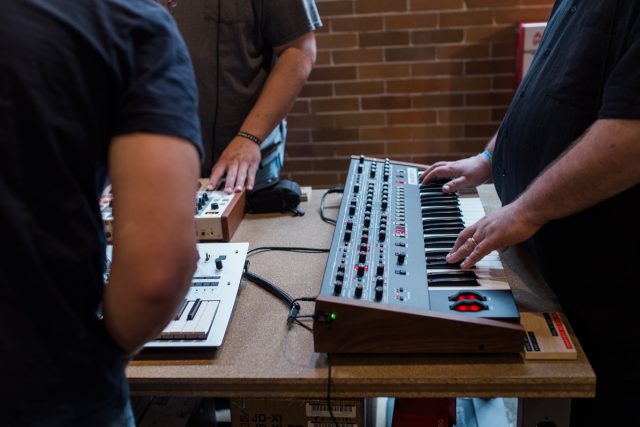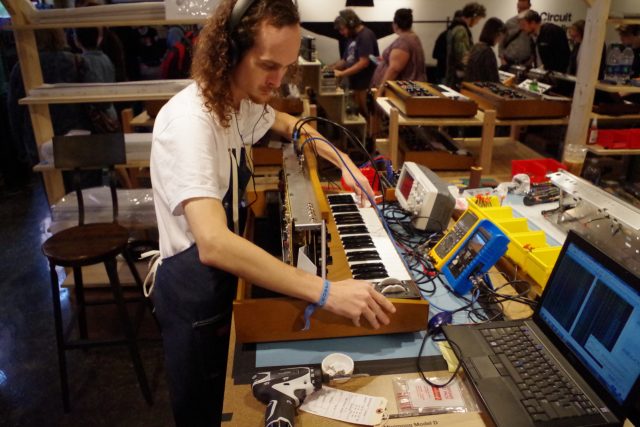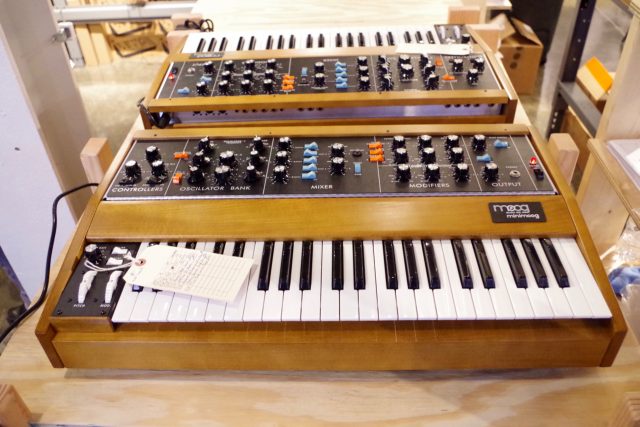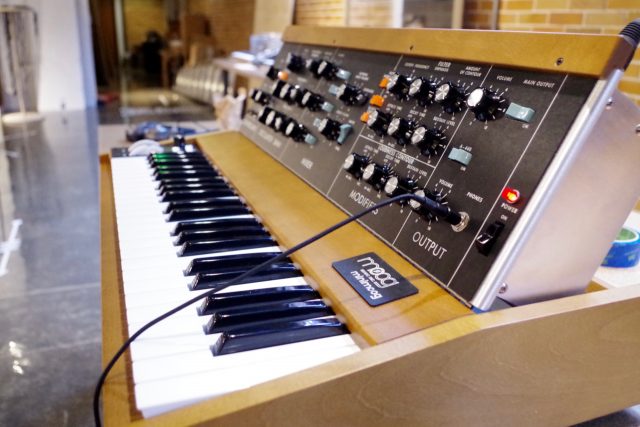
At Moogfest 2016, Moog had a ‘pop-up factory’ set up, where they were assembling the new Minimoog Model D synthesizer.
We talked with Moog’s TJ Mills, who gave us a tour of the Minimoog Model D assembly process:
In the video, Mills discusses what gets done at each stage of their assembly process, and how they calibrate and test the synthesizer once it is assembled.
They start from a collection of individual parts and pre-assembled components from suppliers. Moog had an ‘exploded’ Minimoog at the festival, showing each of the components that make up the new synth:

The circuit boards, for example, are supplied pre-populated, using a variety of new and ‘new old stock’ parts. And the metal and wood components are supplied preshaped and drilled to Moog’s specifications.
In the video below, Moog’s Nick Montoya gives a tour of the inside of the new Minimoog Model D, and explains how they looked for ‘new old stock’ parts and even had some parts manufactured, in order to reproduce the classic Minimoog sound:
The Minimoog Model D is priced at US $3,499. Details are still to be posted at the Moog site.
Here’s a collection of additional images from the Moog Pop-Up Factory at Moogfest:
Additional photos: Eva Lewin Photography




































He was one of the people that built my minimoog voyager! Great guy!
Waiting for “How To Fund A New Minimoog Model D Synthesizer” article
Give plasma, donate blood, sell a kidney…
oh boy, another model d posting. synthtopia should have been announced as continuous advertising site. the minimoog relaunch should not have been accepted uncritically. it´s crazy: the village of trumansburg, ny, installed a historical marker, placed outside of the building that housed moog´s company; a new bob moog documentary has met its kickstarter goal of $100,000 from 700 backers… let´s face it: the moog community became a cult. it revolves around issues such as hero worship and undue influence of little children (during workshops at this year´s moogfest). btw, the welsh minimoog model 204e was way better than the new model d. it introduced several enhancements over the d, namely independent pwm for osc 1 and 2, midi implementation (no retrofit), octave transpose button and multiple envelope triggering (as opposed to the original single triggering). all of which expand the sonic possibilities of the original d. long story short: i would never ever swap my kingkorg or virus snow for a moog. one must be sick in the head to spend $3499 for one note polyphony in 2016 imho.
I don’t think the model d has gotten any more attention than say the volcas did. In fact, I’d argue the original monotron received many more posts. Why? Because it was a big deal at the time. So is this. Skip the article if you are not interested, but there are plenty of people who are.
Describing someone as defective because he or she has different tastes is a bit saddening.
So Rachel can’t see the value in the new Model D.
Neat.
You can chase the dragon, or buy a Moog.
>one must be sick in the head to spend $3499 for one note polyphony in 2016 imho.
You don’t need polyphony for a lead & bass machine and especially for a minimoog.
In that same rationale you would never buy a mercedes or a 19 year old scotch.
It’s not always solely about the end result but the whole experience and believe me it affects the end result as well.
In 2016, there are all kinds of virtual instruments you can use, nobody is stopping you.
But what Moog does is beautiful and pleasing in essence and in substance, aurally and visually (especially in 2016)
I agree. You’d want to be sick in the head to buy a perfect reissue of the most famous synthesiser ever made, for half the price of a vintage one, with more features, and modern reliability. Madness I say!
You’d also have to be mad to pay close to $3000 for two VA synths when you can buy a collection soft synths (same thing) for a couple of hundred dollars.
Each to their own dude.
Well, the soft synths lack two important properties of a musical instrument: look and feel. You won’t get tactile feedback from a soft synth running on a laptop that you’d normally use for emails and Facebook, and you won’t get the same feel from a USB controller as from say an AN1x. Musical instrument is not only sound. It’s everything: looks, aesthetics, feel, and build quality. Soft synths have none of these attributes, unless they’re running on a dedicated host such as the Receptor.
> You’d also have to be mad to pay close to
> $3000 for two VA synths
wrong. my kingkorg has 2 multitimbral parts and 24 note polyphony. my virus snow comes with 4 parts and between 10 and 50 voices. for comparison: moog´s new model d dinosaur has 1 voice, 1 note polyphony and–above all–no midi. give me a break. this is hilarious. i don´t get it.
Rachel
Anyone who’s who’s got experience with both the KingKorg and a Minimoog and a pair of ears knows that they are two entirely different beasts, and each has its place.
Synth players value mono synths like the Minimoog, the Pro One and the Odyssey because of their immediacy – you can reach out and tweak every single parameter while you are playing – and because of their sound.
The Minimoog is also built like a tank – with a case of wood and steel – compared to the lightweight plastic construction of the KingKorg.
Suggesting that all the pros using these mono synths are idiots, because you think you can do it all with your KingKorg, is something that you’d only say if you’re inexperienced and either insecure or angry. That’s not a good place to be making music from.
I hope that you’ll take the time to talk with some musicians that use these instruments and learn from them.
PS: If you were paying attention, instead of venting your anger, you’d know that the new Minimoog does have MIDI support – but pros are going to be more interested in the expanded control voltage capabilities.
Wow. Your KingKorg is only 2 parts multitimbral and your Virus only has 4 parts? My iMac with the whole Arturia and KORG soft synth collections, which cost half of what your two soft synths in a box cost, has unlimited voices and multitimbrality. Bad deal.
Speaking of dinosaurs, how many VA’s will be brought back to life in 20 years when they fail? The Model is is like a great white shark. it evolved to perfection and will survive long after the weaker VA’s are extinct.
Moog is a fashion statement now. What’s not to get.
I have been contemplating selling my Virus TI 2 Polar and my Korg Mono/Poly to get a Minimoog. I barely use either and I know for damn sure I would use the minimoog because it’s just immediate. The virus is just a nightmare in my opinion. I haven’t touched it because I’m super lazy to figure out how to dive into the menu. While a minimoog I’d be able to see everything. I KNOW that it would feel great too. Just the clicks of those knobs would be worth $3k lol …cmon…it’s a damn MINIMOOG! no damn virus or VA synth can compare to the raw beast of sound that just 1 oscillator on the moog will make.
Mono/Poly is very cool. Minimoog is definitely better, but I’d try hold onto the Monopoly as they’re only headed one direction price wise, unless Korg reissue it. Which is looking increasingly possibly these days!
Yeah, that’s what I’m worried about. I like it, but I can’t ever seem to get the voice allocation to go the right way. It’s as if I get the highest note to play the lowest oscillator and vice versa. Strange beast. I’d love to get my hands on a minimoog though!
It’s a strange beast. And sometimes unrewarding, but unique. I don’t use mine often, but when I do it’s usually something special. Minimoog would be more rewarding and more useful, but monopoly is worth keeping if possible.